CIPD 5DBC Report: Analysis of L&D Metrics and Data Sources
VerifiedAdded on 2022/08/29
|18
|4644
|18
Report
AI Summary
This report, submitted as part of a CIPD (Chartered Institute of Personnel and Development) assignment, focuses on the critical aspects of Learning and Development (L&D) within an organization. It begins by defining and classifying various metrics used to measure the effectiveness of L&D initiatives, including qualitative, quantitative, input, output, and efficiency metrics. The report provides workplace examples such as training spend, employee performance, and return on investment (ROI). It then delves into the evaluation of primary and secondary data sources, highlighting the importance of interviews, surveys, direct observation, and company records. The student's research includes case studies and analysis of how L&D policies are implemented, specifically within a sales and marketing company, and how data collection methods such as interviews and surveys are used to gather information. The findings discuss employee motivation, sales performance, and the impact of L&D on these key areas. Finally, the report provides recommendations for enhancing the effectiveness of L&D programs, suggesting ways to improve employee performance and achieve business objectives, as well as identifying the limitations of the research.
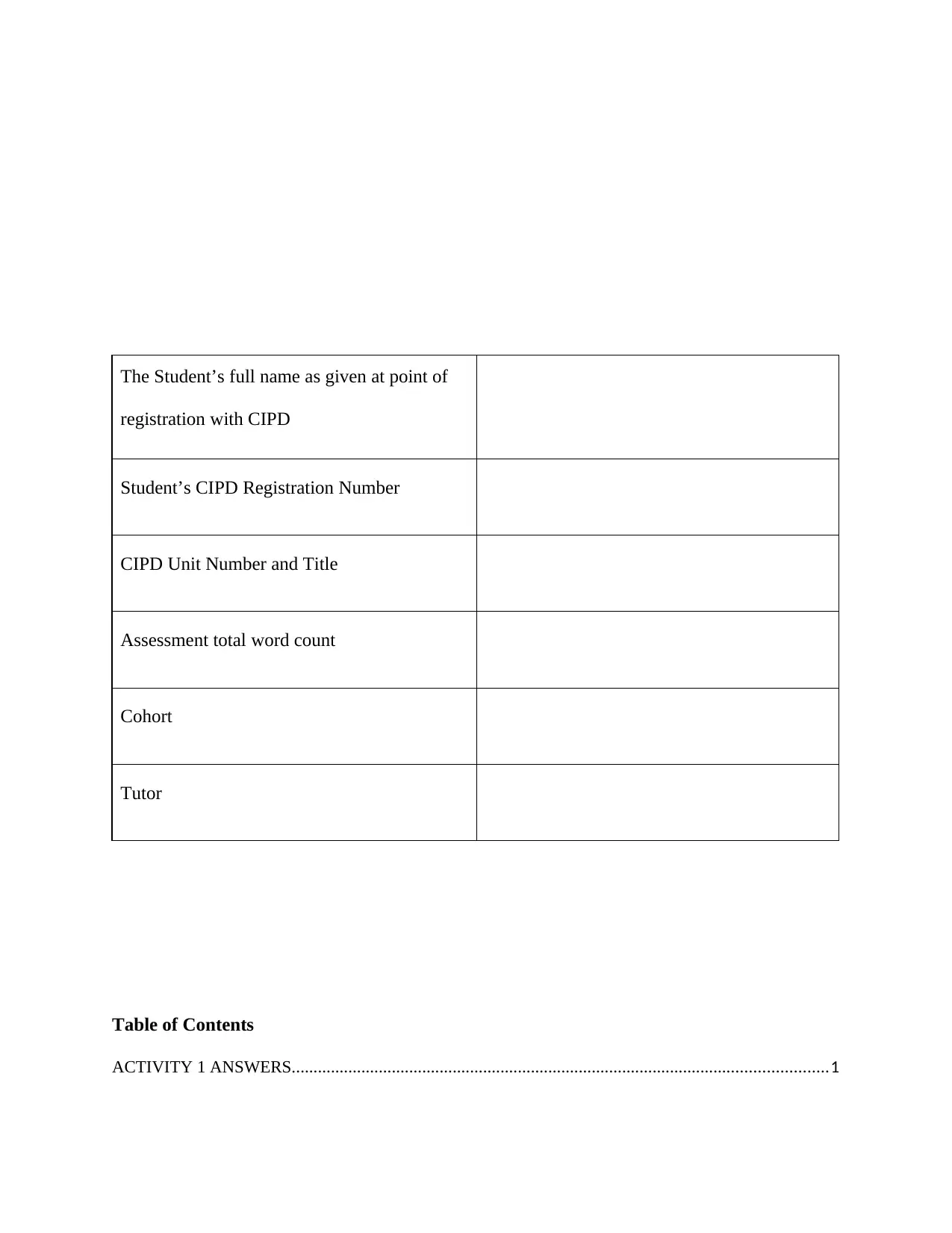
The Student’s full name as given at point of
registration with CIPD
Student’s CIPD Registration Number
CIPD Unit Number and Title
Assessment total word count
Cohort
Tutor
Table of Contents
ACTIVITY 1 ANSWERS...........................................................................................................................1
registration with CIPD
Student’s CIPD Registration Number
CIPD Unit Number and Title
Assessment total word count
Cohort
Tutor
Table of Contents
ACTIVITY 1 ANSWERS...........................................................................................................................1
Paraphrase This Document
Need a fresh take? Get an instant paraphrase of this document with our AI Paraphraser

AC 1.1.........................................................................................................................................................1
AC 1.2.........................................................................................................................................................3
ACTIVITY 2 ANSWERS...........................................................................................................................4
AC 2.1.........................................................................................................................................................4
AC 2.2.........................................................................................................................................................5
AC 2.3.........................................................................................................................................................8
AC 2.4.......................................................................................................................................................11
AC 2.6.......................................................................................................................................................11
AC 2.5.......................................................................................................................................................13
References................................................................................................................................................14
Table 1. Sales made per month by employees............................................................................................8
Table 2. Employee's motivation to their posts............................................................................................9
ACTIVITY 1 ANSWERS.
AC 1.1
Metrics broadly refer to measurement of something with an aim of obtaining quantifiable results
that will be compared with other standards (Dai and Berleant, 2019). This helps identify how
well a certain activity has been done. There are various methods that are used to classify metrics.
Qualitative metrics are used to measure success of a program over a period of time. Examples
include, learner promoter score and Learning attention and retention. Input metrics measure the
recourses used to produce an output. Output metrics on the other hand measure what was
AC 1.2.........................................................................................................................................................3
ACTIVITY 2 ANSWERS...........................................................................................................................4
AC 2.1.........................................................................................................................................................4
AC 2.2.........................................................................................................................................................5
AC 2.3.........................................................................................................................................................8
AC 2.4.......................................................................................................................................................11
AC 2.6.......................................................................................................................................................11
AC 2.5.......................................................................................................................................................13
References................................................................................................................................................14
Table 1. Sales made per month by employees............................................................................................8
Table 2. Employee's motivation to their posts............................................................................................9
ACTIVITY 1 ANSWERS.
AC 1.1
Metrics broadly refer to measurement of something with an aim of obtaining quantifiable results
that will be compared with other standards (Dai and Berleant, 2019). This helps identify how
well a certain activity has been done. There are various methods that are used to classify metrics.
Qualitative metrics are used to measure success of a program over a period of time. Examples
include, learner promoter score and Learning attention and retention. Input metrics measure the
recourses used to produce an output. Output metrics on the other hand measure what was
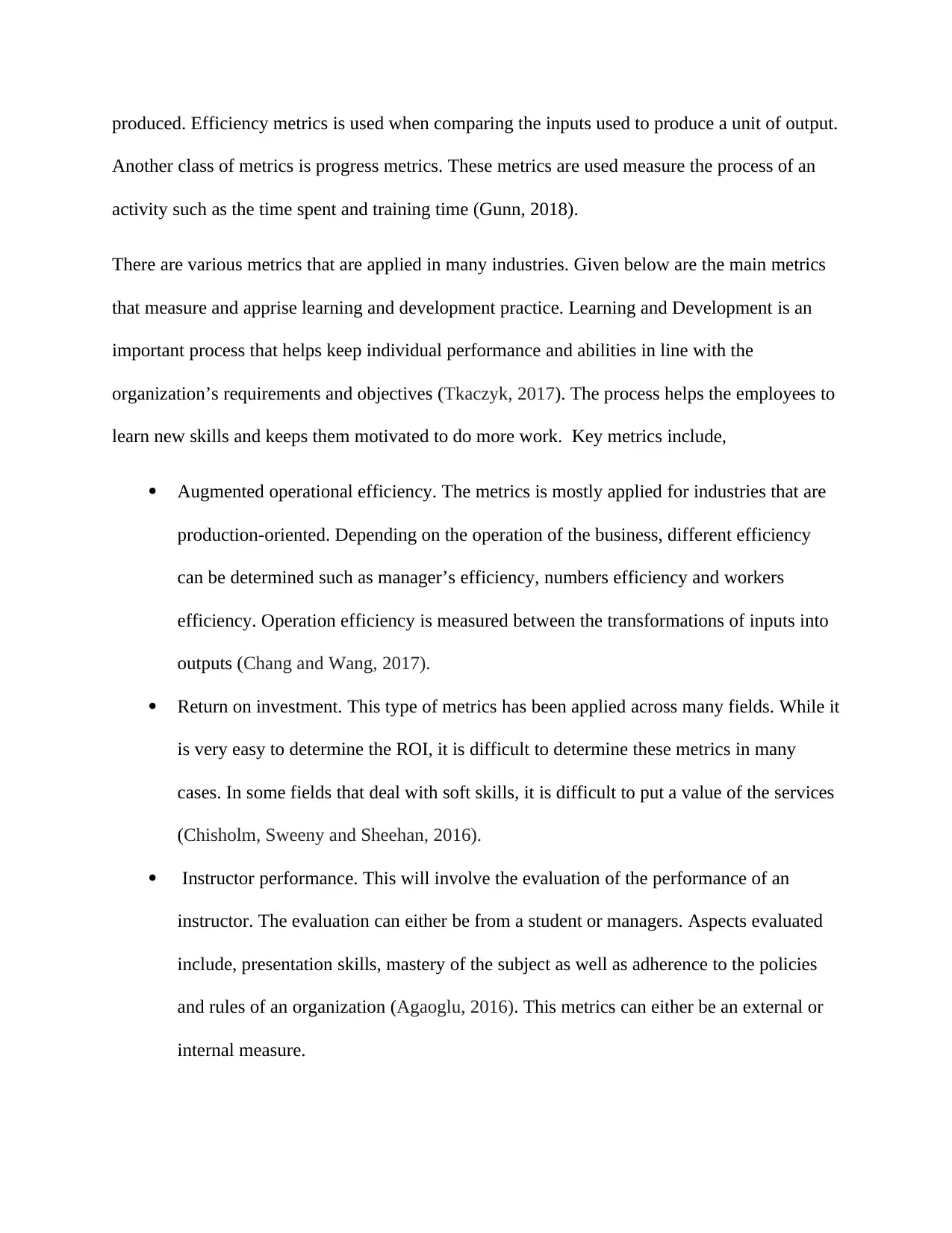
produced. Efficiency metrics is used when comparing the inputs used to produce a unit of output.
Another class of metrics is progress metrics. These metrics are used measure the process of an
activity such as the time spent and training time (Gunn, 2018).
There are various metrics that are applied in many industries. Given below are the main metrics
that measure and apprise learning and development practice. Learning and Development is an
important process that helps keep individual performance and abilities in line with the
organization’s requirements and objectives (Tkaczyk, 2017). The process helps the employees to
learn new skills and keeps them motivated to do more work. Key metrics include,
Augmented operational efficiency. The metrics is mostly applied for industries that are
production-oriented. Depending on the operation of the business, different efficiency
can be determined such as manager’s efficiency, numbers efficiency and workers
efficiency. Operation efficiency is measured between the transformations of inputs into
outputs (Chang and Wang, 2017).
Return on investment. This type of metrics has been applied across many fields. While it
is very easy to determine the ROI, it is difficult to determine these metrics in many
cases. In some fields that deal with soft skills, it is difficult to put a value of the services
(Chisholm, Sweeny and Sheehan, 2016).
Instructor performance. This will involve the evaluation of the performance of an
instructor. The evaluation can either be from a student or managers. Aspects evaluated
include, presentation skills, mastery of the subject as well as adherence to the policies
and rules of an organization (Agaoglu, 2016). This metrics can either be an external or
internal measure.
Another class of metrics is progress metrics. These metrics are used measure the process of an
activity such as the time spent and training time (Gunn, 2018).
There are various metrics that are applied in many industries. Given below are the main metrics
that measure and apprise learning and development practice. Learning and Development is an
important process that helps keep individual performance and abilities in line with the
organization’s requirements and objectives (Tkaczyk, 2017). The process helps the employees to
learn new skills and keeps them motivated to do more work. Key metrics include,
Augmented operational efficiency. The metrics is mostly applied for industries that are
production-oriented. Depending on the operation of the business, different efficiency
can be determined such as manager’s efficiency, numbers efficiency and workers
efficiency. Operation efficiency is measured between the transformations of inputs into
outputs (Chang and Wang, 2017).
Return on investment. This type of metrics has been applied across many fields. While it
is very easy to determine the ROI, it is difficult to determine these metrics in many
cases. In some fields that deal with soft skills, it is difficult to put a value of the services
(Chisholm, Sweeny and Sheehan, 2016).
Instructor performance. This will involve the evaluation of the performance of an
instructor. The evaluation can either be from a student or managers. Aspects evaluated
include, presentation skills, mastery of the subject as well as adherence to the policies
and rules of an organization (Agaoglu, 2016). This metrics can either be an external or
internal measure.
⊘ This is a preview!⊘
Do you want full access?
Subscribe today to unlock all pages.

Trusted by 1+ million students worldwide
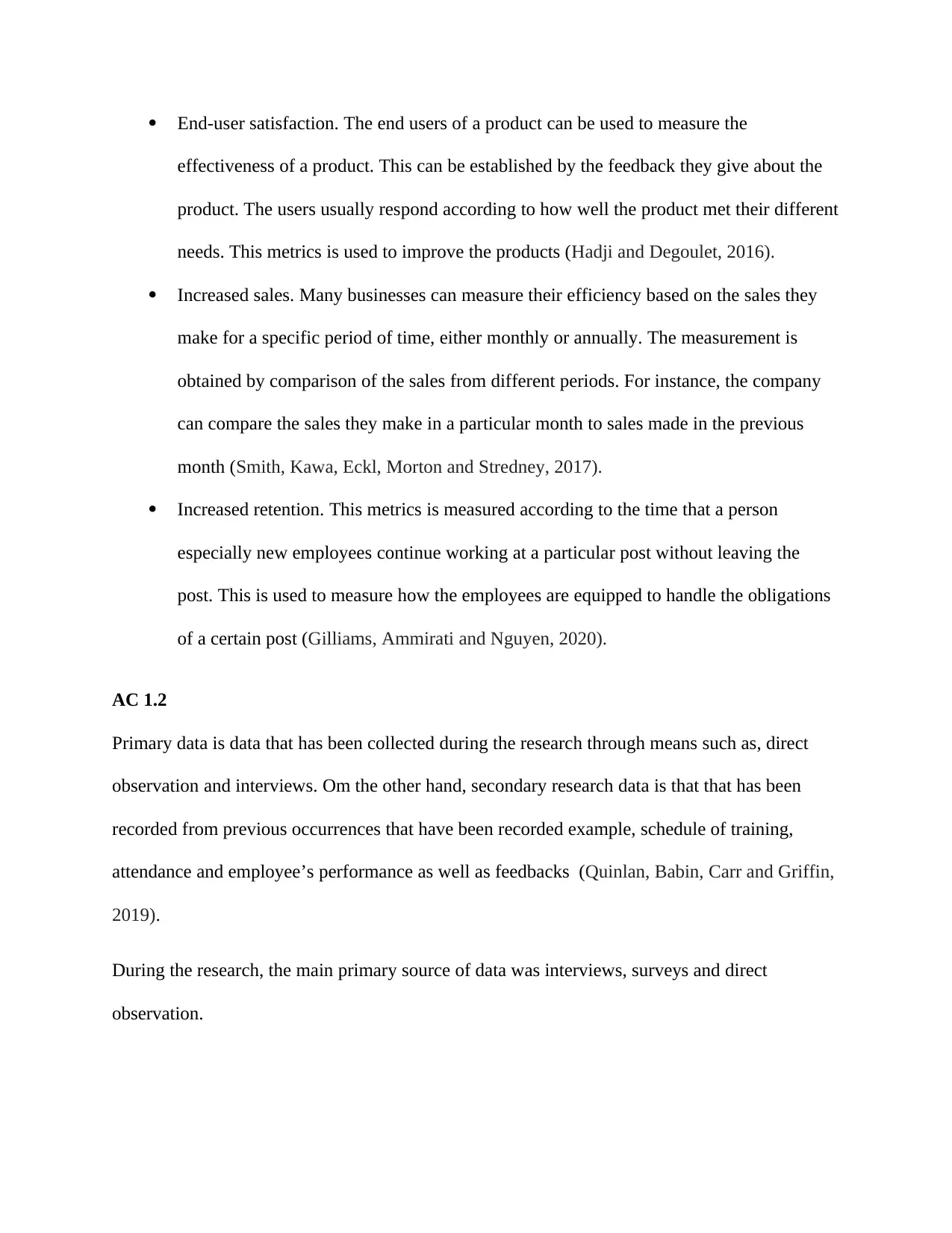
End-user satisfaction. The end users of a product can be used to measure the
effectiveness of a product. This can be established by the feedback they give about the
product. The users usually respond according to how well the product met their different
needs. This metrics is used to improve the products (Hadji and Degoulet, 2016).
Increased sales. Many businesses can measure their efficiency based on the sales they
make for a specific period of time, either monthly or annually. The measurement is
obtained by comparison of the sales from different periods. For instance, the company
can compare the sales they make in a particular month to sales made in the previous
month (Smith, Kawa, Eckl, Morton and Stredney, 2017).
Increased retention. This metrics is measured according to the time that a person
especially new employees continue working at a particular post without leaving the
post. This is used to measure how the employees are equipped to handle the obligations
of a certain post (Gilliams, Ammirati and Nguyen, 2020).
AC 1.2
Primary data is data that has been collected during the research through means such as, direct
observation and interviews. Om the other hand, secondary research data is that that has been
recorded from previous occurrences that have been recorded example, schedule of training,
attendance and employee’s performance as well as feedbacks (Quinlan, Babin, Carr and Griffin,
2019).
During the research, the main primary source of data was interviews, surveys and direct
observation.
effectiveness of a product. This can be established by the feedback they give about the
product. The users usually respond according to how well the product met their different
needs. This metrics is used to improve the products (Hadji and Degoulet, 2016).
Increased sales. Many businesses can measure their efficiency based on the sales they
make for a specific period of time, either monthly or annually. The measurement is
obtained by comparison of the sales from different periods. For instance, the company
can compare the sales they make in a particular month to sales made in the previous
month (Smith, Kawa, Eckl, Morton and Stredney, 2017).
Increased retention. This metrics is measured according to the time that a person
especially new employees continue working at a particular post without leaving the
post. This is used to measure how the employees are equipped to handle the obligations
of a certain post (Gilliams, Ammirati and Nguyen, 2020).
AC 1.2
Primary data is data that has been collected during the research through means such as, direct
observation and interviews. Om the other hand, secondary research data is that that has been
recorded from previous occurrences that have been recorded example, schedule of training,
attendance and employee’s performance as well as feedbacks (Quinlan, Babin, Carr and Griffin,
2019).
During the research, the main primary source of data was interviews, surveys and direct
observation.
Paraphrase This Document
Need a fresh take? Get an instant paraphrase of this document with our AI Paraphraser
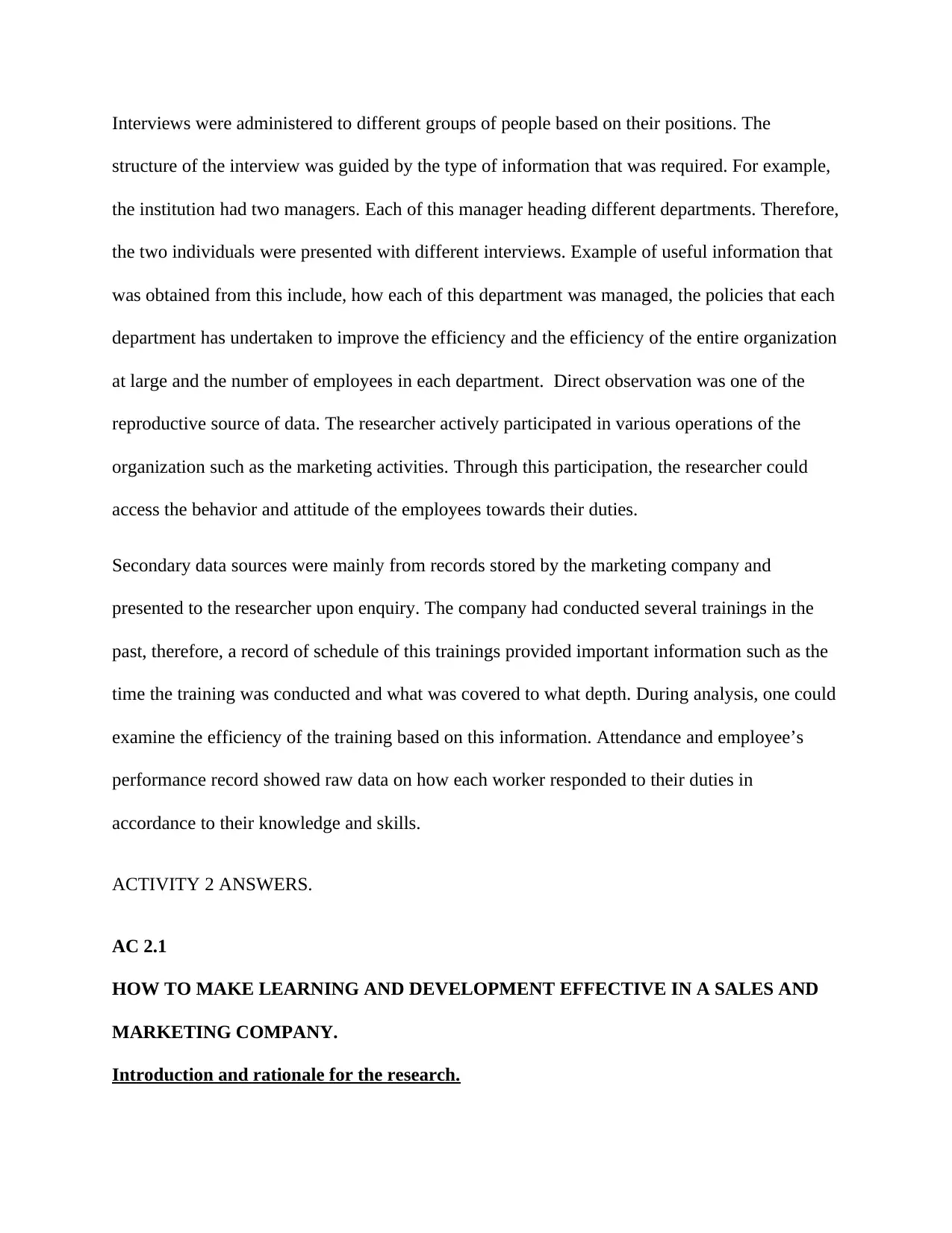
Interviews were administered to different groups of people based on their positions. The
structure of the interview was guided by the type of information that was required. For example,
the institution had two managers. Each of this manager heading different departments. Therefore,
the two individuals were presented with different interviews. Example of useful information that
was obtained from this include, how each of this department was managed, the policies that each
department has undertaken to improve the efficiency and the efficiency of the entire organization
at large and the number of employees in each department. Direct observation was one of the
reproductive source of data. The researcher actively participated in various operations of the
organization such as the marketing activities. Through this participation, the researcher could
access the behavior and attitude of the employees towards their duties.
Secondary data sources were mainly from records stored by the marketing company and
presented to the researcher upon enquiry. The company had conducted several trainings in the
past, therefore, a record of schedule of this trainings provided important information such as the
time the training was conducted and what was covered to what depth. During analysis, one could
examine the efficiency of the training based on this information. Attendance and employee’s
performance record showed raw data on how each worker responded to their duties in
accordance to their knowledge and skills.
ACTIVITY 2 ANSWERS.
AC 2.1
HOW TO MAKE LEARNING AND DEVELOPMENT EFFECTIVE IN A SALES AND
MARKETING COMPANY.
Introduction and rationale for the research.
structure of the interview was guided by the type of information that was required. For example,
the institution had two managers. Each of this manager heading different departments. Therefore,
the two individuals were presented with different interviews. Example of useful information that
was obtained from this include, how each of this department was managed, the policies that each
department has undertaken to improve the efficiency and the efficiency of the entire organization
at large and the number of employees in each department. Direct observation was one of the
reproductive source of data. The researcher actively participated in various operations of the
organization such as the marketing activities. Through this participation, the researcher could
access the behavior and attitude of the employees towards their duties.
Secondary data sources were mainly from records stored by the marketing company and
presented to the researcher upon enquiry. The company had conducted several trainings in the
past, therefore, a record of schedule of this trainings provided important information such as the
time the training was conducted and what was covered to what depth. During analysis, one could
examine the efficiency of the training based on this information. Attendance and employee’s
performance record showed raw data on how each worker responded to their duties in
accordance to their knowledge and skills.
ACTIVITY 2 ANSWERS.
AC 2.1
HOW TO MAKE LEARNING AND DEVELOPMENT EFFECTIVE IN A SALES AND
MARKETING COMPANY.
Introduction and rationale for the research.
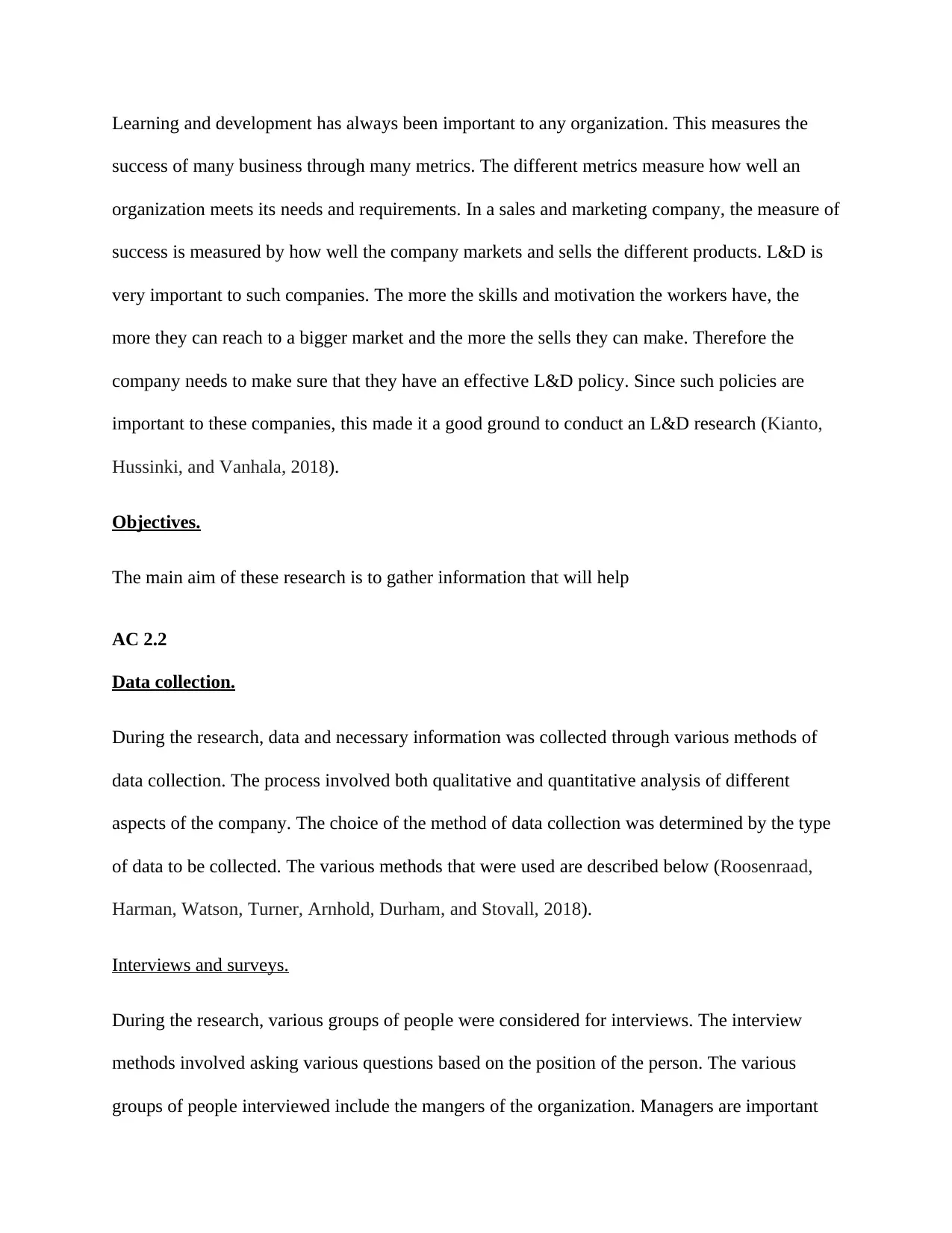
Learning and development has always been important to any organization. This measures the
success of many business through many metrics. The different metrics measure how well an
organization meets its needs and requirements. In a sales and marketing company, the measure of
success is measured by how well the company markets and sells the different products. L&D is
very important to such companies. The more the skills and motivation the workers have, the
more they can reach to a bigger market and the more the sells they can make. Therefore the
company needs to make sure that they have an effective L&D policy. Since such policies are
important to these companies, this made it a good ground to conduct an L&D research (Kianto,
Hussinki, and Vanhala, 2018).
Objectives.
The main aim of these research is to gather information that will help
AC 2.2
Data collection.
During the research, data and necessary information was collected through various methods of
data collection. The process involved both qualitative and quantitative analysis of different
aspects of the company. The choice of the method of data collection was determined by the type
of data to be collected. The various methods that were used are described below (Roosenraad,
Harman, Watson, Turner, Arnhold, Durham, and Stovall, 2018).
Interviews and surveys.
During the research, various groups of people were considered for interviews. The interview
methods involved asking various questions based on the position of the person. The various
groups of people interviewed include the mangers of the organization. Managers are important
success of many business through many metrics. The different metrics measure how well an
organization meets its needs and requirements. In a sales and marketing company, the measure of
success is measured by how well the company markets and sells the different products. L&D is
very important to such companies. The more the skills and motivation the workers have, the
more they can reach to a bigger market and the more the sells they can make. Therefore the
company needs to make sure that they have an effective L&D policy. Since such policies are
important to these companies, this made it a good ground to conduct an L&D research (Kianto,
Hussinki, and Vanhala, 2018).
Objectives.
The main aim of these research is to gather information that will help
AC 2.2
Data collection.
During the research, data and necessary information was collected through various methods of
data collection. The process involved both qualitative and quantitative analysis of different
aspects of the company. The choice of the method of data collection was determined by the type
of data to be collected. The various methods that were used are described below (Roosenraad,
Harman, Watson, Turner, Arnhold, Durham, and Stovall, 2018).
Interviews and surveys.
During the research, various groups of people were considered for interviews. The interview
methods involved asking various questions based on the position of the person. The various
groups of people interviewed include the mangers of the organization. Managers are important
⊘ This is a preview!⊘
Do you want full access?
Subscribe today to unlock all pages.

Trusted by 1+ million students worldwide
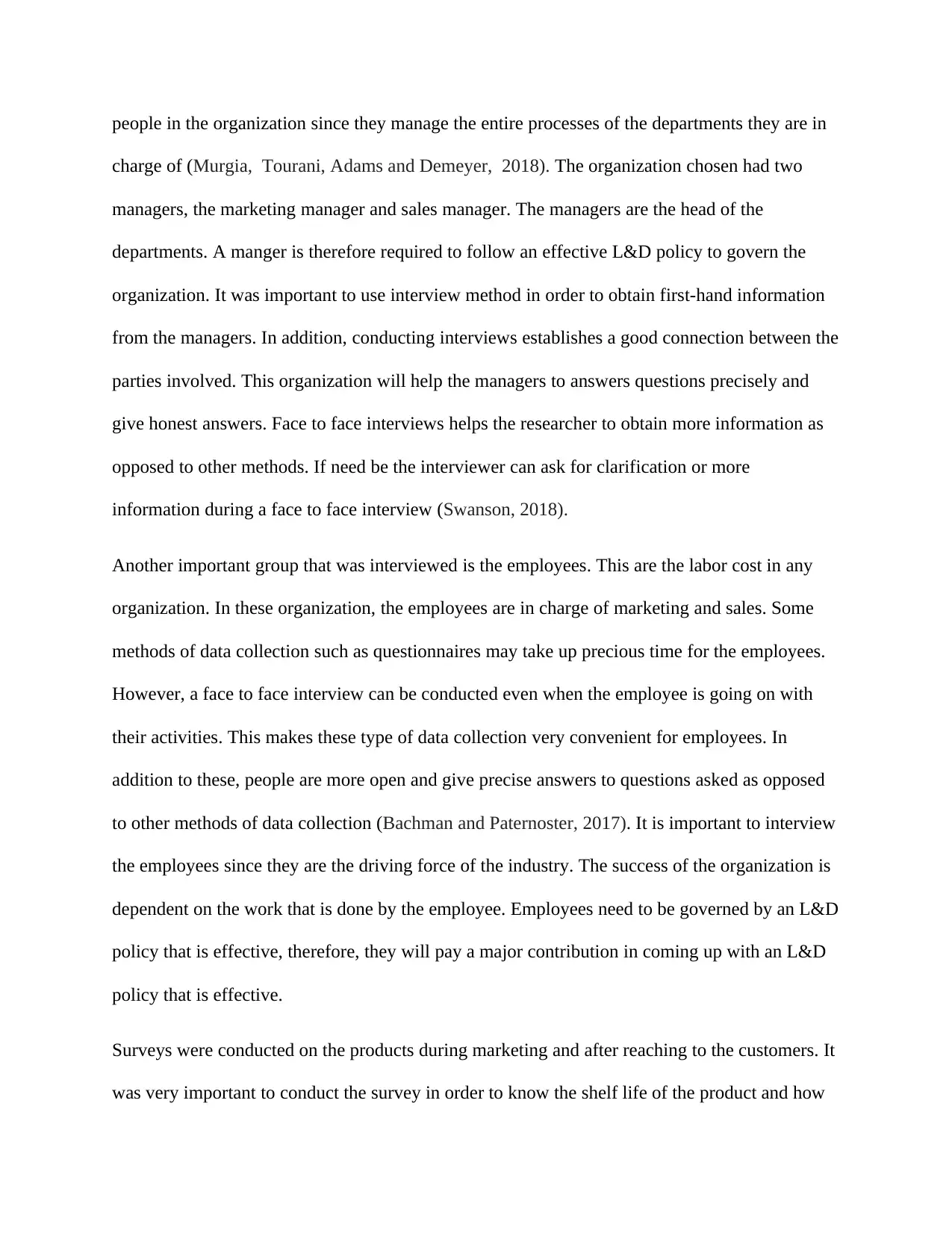
people in the organization since they manage the entire processes of the departments they are in
charge of (Murgia, Tourani, Adams and Demeyer, 2018). The organization chosen had two
managers, the marketing manager and sales manager. The managers are the head of the
departments. A manger is therefore required to follow an effective L&D policy to govern the
organization. It was important to use interview method in order to obtain first-hand information
from the managers. In addition, conducting interviews establishes a good connection between the
parties involved. This organization will help the managers to answers questions precisely and
give honest answers. Face to face interviews helps the researcher to obtain more information as
opposed to other methods. If need be the interviewer can ask for clarification or more
information during a face to face interview (Swanson, 2018).
Another important group that was interviewed is the employees. This are the labor cost in any
organization. In these organization, the employees are in charge of marketing and sales. Some
methods of data collection such as questionnaires may take up precious time for the employees.
However, a face to face interview can be conducted even when the employee is going on with
their activities. This makes these type of data collection very convenient for employees. In
addition to these, people are more open and give precise answers to questions asked as opposed
to other methods of data collection (Bachman and Paternoster, 2017). It is important to interview
the employees since they are the driving force of the industry. The success of the organization is
dependent on the work that is done by the employee. Employees need to be governed by an L&D
policy that is effective, therefore, they will pay a major contribution in coming up with an L&D
policy that is effective.
Surveys were conducted on the products during marketing and after reaching to the customers. It
was very important to conduct the survey in order to know the shelf life of the product and how
charge of (Murgia, Tourani, Adams and Demeyer, 2018). The organization chosen had two
managers, the marketing manager and sales manager. The managers are the head of the
departments. A manger is therefore required to follow an effective L&D policy to govern the
organization. It was important to use interview method in order to obtain first-hand information
from the managers. In addition, conducting interviews establishes a good connection between the
parties involved. This organization will help the managers to answers questions precisely and
give honest answers. Face to face interviews helps the researcher to obtain more information as
opposed to other methods. If need be the interviewer can ask for clarification or more
information during a face to face interview (Swanson, 2018).
Another important group that was interviewed is the employees. This are the labor cost in any
organization. In these organization, the employees are in charge of marketing and sales. Some
methods of data collection such as questionnaires may take up precious time for the employees.
However, a face to face interview can be conducted even when the employee is going on with
their activities. This makes these type of data collection very convenient for employees. In
addition to these, people are more open and give precise answers to questions asked as opposed
to other methods of data collection (Bachman and Paternoster, 2017). It is important to interview
the employees since they are the driving force of the industry. The success of the organization is
dependent on the work that is done by the employee. Employees need to be governed by an L&D
policy that is effective, therefore, they will pay a major contribution in coming up with an L&D
policy that is effective.
Surveys were conducted on the products during marketing and after reaching to the customers. It
was very important to conduct the survey in order to know the shelf life of the product and how
Paraphrase This Document
Need a fresh take? Get an instant paraphrase of this document with our AI Paraphraser
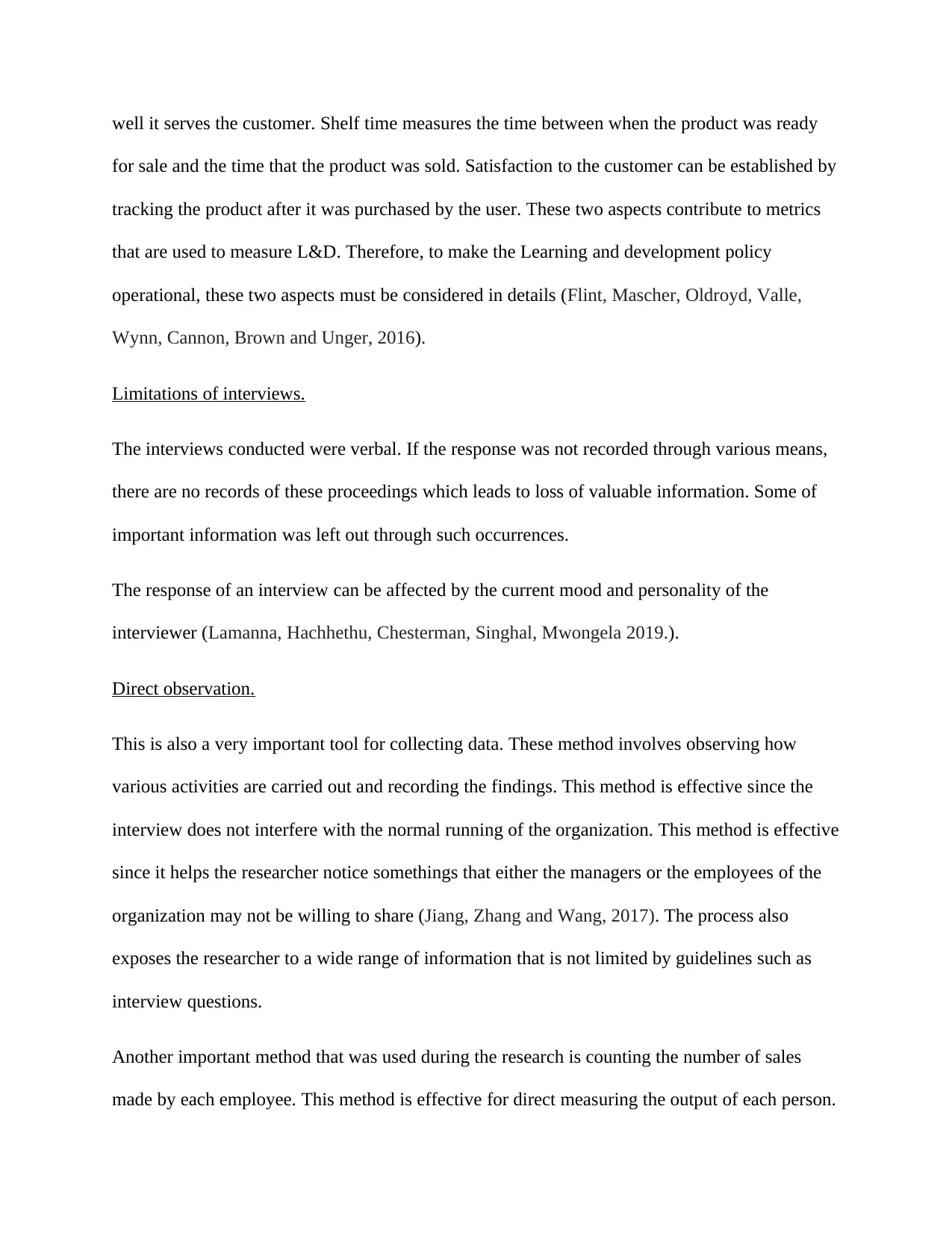
well it serves the customer. Shelf time measures the time between when the product was ready
for sale and the time that the product was sold. Satisfaction to the customer can be established by
tracking the product after it was purchased by the user. These two aspects contribute to metrics
that are used to measure L&D. Therefore, to make the Learning and development policy
operational, these two aspects must be considered in details (Flint, Mascher, Oldroyd, Valle,
Wynn, Cannon, Brown and Unger, 2016).
Limitations of interviews.
The interviews conducted were verbal. If the response was not recorded through various means,
there are no records of these proceedings which leads to loss of valuable information. Some of
important information was left out through such occurrences.
The response of an interview can be affected by the current mood and personality of the
interviewer (Lamanna, Hachhethu, Chesterman, Singhal, Mwongela 2019.).
Direct observation.
This is also a very important tool for collecting data. These method involves observing how
various activities are carried out and recording the findings. This method is effective since the
interview does not interfere with the normal running of the organization. This method is effective
since it helps the researcher notice somethings that either the managers or the employees of the
organization may not be willing to share (Jiang, Zhang and Wang, 2017). The process also
exposes the researcher to a wide range of information that is not limited by guidelines such as
interview questions.
Another important method that was used during the research is counting the number of sales
made by each employee. This method is effective for direct measuring the output of each person.
for sale and the time that the product was sold. Satisfaction to the customer can be established by
tracking the product after it was purchased by the user. These two aspects contribute to metrics
that are used to measure L&D. Therefore, to make the Learning and development policy
operational, these two aspects must be considered in details (Flint, Mascher, Oldroyd, Valle,
Wynn, Cannon, Brown and Unger, 2016).
Limitations of interviews.
The interviews conducted were verbal. If the response was not recorded through various means,
there are no records of these proceedings which leads to loss of valuable information. Some of
important information was left out through such occurrences.
The response of an interview can be affected by the current mood and personality of the
interviewer (Lamanna, Hachhethu, Chesterman, Singhal, Mwongela 2019.).
Direct observation.
This is also a very important tool for collecting data. These method involves observing how
various activities are carried out and recording the findings. This method is effective since the
interview does not interfere with the normal running of the organization. This method is effective
since it helps the researcher notice somethings that either the managers or the employees of the
organization may not be willing to share (Jiang, Zhang and Wang, 2017). The process also
exposes the researcher to a wide range of information that is not limited by guidelines such as
interview questions.
Another important method that was used during the research is counting the number of sales
made by each employee. This method is effective for direct measuring the output of each person.
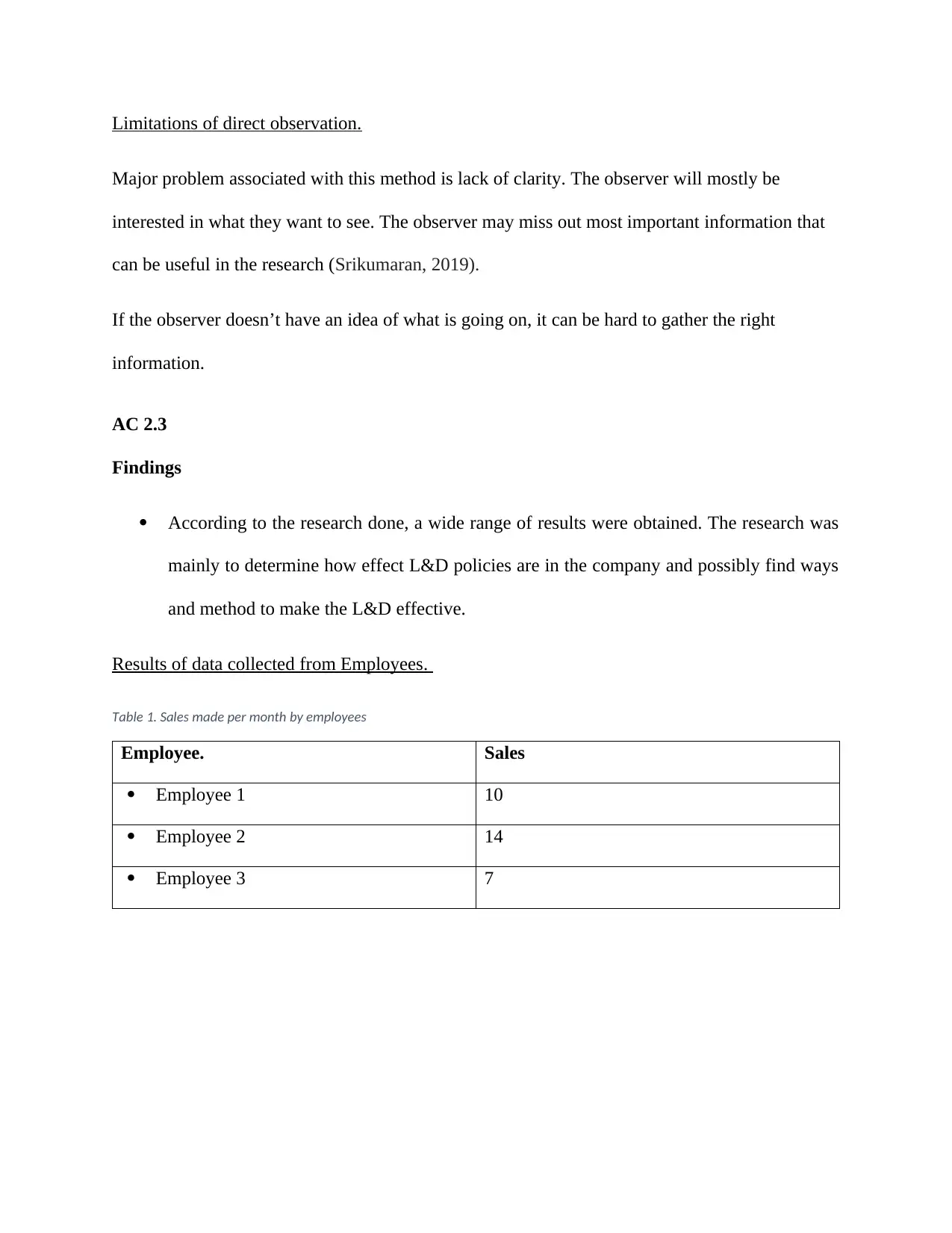
Limitations of direct observation.
Major problem associated with this method is lack of clarity. The observer will mostly be
interested in what they want to see. The observer may miss out most important information that
can be useful in the research (Srikumaran, 2019).
If the observer doesn’t have an idea of what is going on, it can be hard to gather the right
information.
AC 2.3
Findings
According to the research done, a wide range of results were obtained. The research was
mainly to determine how effect L&D policies are in the company and possibly find ways
and method to make the L&D effective.
Results of data collected from Employees.
Table 1. Sales made per month by employees
Employee. Sales
Employee 1 10
Employee 2 14
Employee 3 7
Major problem associated with this method is lack of clarity. The observer will mostly be
interested in what they want to see. The observer may miss out most important information that
can be useful in the research (Srikumaran, 2019).
If the observer doesn’t have an idea of what is going on, it can be hard to gather the right
information.
AC 2.3
Findings
According to the research done, a wide range of results were obtained. The research was
mainly to determine how effect L&D policies are in the company and possibly find ways
and method to make the L&D effective.
Results of data collected from Employees.
Table 1. Sales made per month by employees
Employee. Sales
Employee 1 10
Employee 2 14
Employee 3 7
⊘ This is a preview!⊘
Do you want full access?
Subscribe today to unlock all pages.

Trusted by 1+ million students worldwide

Table 2. Employee's motivation to their posts
employee's motivation.
Not motvated Moivated
Discussion 1
It was clear that the employees don’t have the right motivation to go around various activities.
Some of them had issues that limited their ability to give their best. However, most of them were
satisfied with what they were doing and believed that what they were doing was their best.
The work of an employee is measured by the amount of products they sell in a month. The
employer has a policy of rewarding the best employee every month. The employee with the most
sales is given a token of appreciation that motivates them as well as other employees.
Managers
Monthly targets.
Marketing manager.
a) Surpass previous month sales.
employee's motivation.
Not motvated Moivated
Discussion 1
It was clear that the employees don’t have the right motivation to go around various activities.
Some of them had issues that limited their ability to give their best. However, most of them were
satisfied with what they were doing and believed that what they were doing was their best.
The work of an employee is measured by the amount of products they sell in a month. The
employer has a policy of rewarding the best employee every month. The employee with the most
sales is given a token of appreciation that motivates them as well as other employees.
Managers
Monthly targets.
Marketing manager.
a) Surpass previous month sales.
Paraphrase This Document
Need a fresh take? Get an instant paraphrase of this document with our AI Paraphraser

b) Employ one more employee.
Sales manager.
a) Increase sales by 25%
b) Monitor the progress of each employee.
Both departments were using internet based network and mobile, web-based and desktop
applications.
Targets were set based on the market competitiveness from other industries.
Direct observations and surveys identified that upon selling a product, a follow-up was not
employed to find out the effectiveness of the product to the customers. Both managers also
confirmed this through interviews.
Discussion 2
Each manager has put in policies in their departments to make sure that their employees work
hard every time. In both departments, each manager sets a monthly target that they must achieve.
At the end of every month, the manager will evaluate the achievements of that month against the
target that was set for that month. Based on the comparison, the managers will analyze the results
and come up with a conclusion. For instance if the target was met, the manager can set a higher
target for the next month. If the target was not met, the manager will put in new strategies for the
coming month that will help them achieve that target.
Managers use other competitive industries as their benchmarks. Usually, the managers will
compare their progress with the progress of a company that is doing better than them. They will
learn the strategies that the benchmark company is following and either try to do like that
company or improve on their strategies so that to have a competitive advantage over them. This
policy has helped the company improve on their products and keep up a competitive
environment with other companies.
Sales manager.
a) Increase sales by 25%
b) Monitor the progress of each employee.
Both departments were using internet based network and mobile, web-based and desktop
applications.
Targets were set based on the market competitiveness from other industries.
Direct observations and surveys identified that upon selling a product, a follow-up was not
employed to find out the effectiveness of the product to the customers. Both managers also
confirmed this through interviews.
Discussion 2
Each manager has put in policies in their departments to make sure that their employees work
hard every time. In both departments, each manager sets a monthly target that they must achieve.
At the end of every month, the manager will evaluate the achievements of that month against the
target that was set for that month. Based on the comparison, the managers will analyze the results
and come up with a conclusion. For instance if the target was met, the manager can set a higher
target for the next month. If the target was not met, the manager will put in new strategies for the
coming month that will help them achieve that target.
Managers use other competitive industries as their benchmarks. Usually, the managers will
compare their progress with the progress of a company that is doing better than them. They will
learn the strategies that the benchmark company is following and either try to do like that
company or improve on their strategies so that to have a competitive advantage over them. This
policy has helped the company improve on their products and keep up a competitive
environment with other companies.
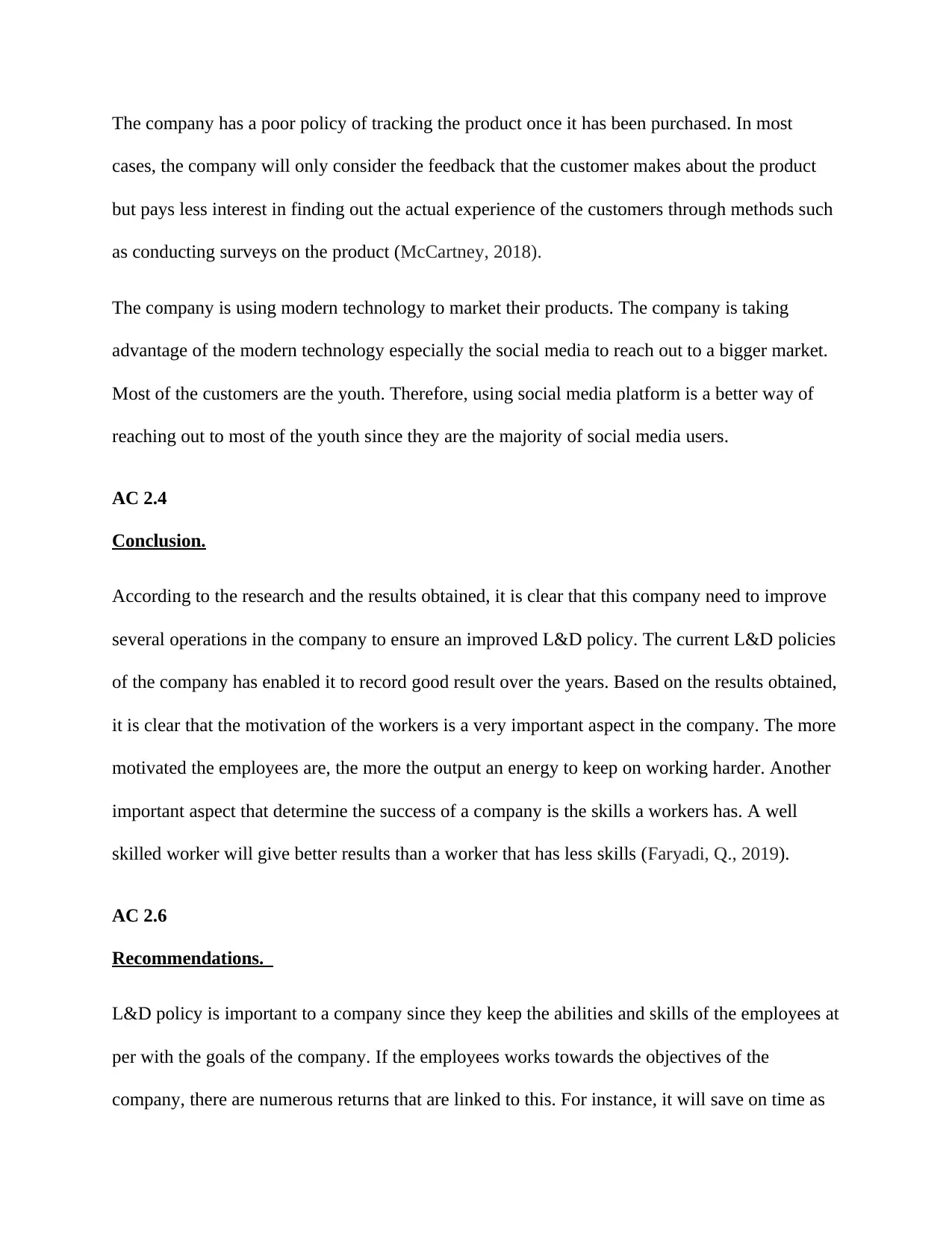
The company has a poor policy of tracking the product once it has been purchased. In most
cases, the company will only consider the feedback that the customer makes about the product
but pays less interest in finding out the actual experience of the customers through methods such
as conducting surveys on the product (McCartney, 2018).
The company is using modern technology to market their products. The company is taking
advantage of the modern technology especially the social media to reach out to a bigger market.
Most of the customers are the youth. Therefore, using social media platform is a better way of
reaching out to most of the youth since they are the majority of social media users.
AC 2.4
Conclusion.
According to the research and the results obtained, it is clear that this company need to improve
several operations in the company to ensure an improved L&D policy. The current L&D policies
of the company has enabled it to record good result over the years. Based on the results obtained,
it is clear that the motivation of the workers is a very important aspect in the company. The more
motivated the employees are, the more the output an energy to keep on working harder. Another
important aspect that determine the success of a company is the skills a workers has. A well
skilled worker will give better results than a worker that has less skills (Faryadi, Q., 2019).
AC 2.6
Recommendations.
L&D policy is important to a company since they keep the abilities and skills of the employees at
per with the goals of the company. If the employees works towards the objectives of the
company, there are numerous returns that are linked to this. For instance, it will save on time as
cases, the company will only consider the feedback that the customer makes about the product
but pays less interest in finding out the actual experience of the customers through methods such
as conducting surveys on the product (McCartney, 2018).
The company is using modern technology to market their products. The company is taking
advantage of the modern technology especially the social media to reach out to a bigger market.
Most of the customers are the youth. Therefore, using social media platform is a better way of
reaching out to most of the youth since they are the majority of social media users.
AC 2.4
Conclusion.
According to the research and the results obtained, it is clear that this company need to improve
several operations in the company to ensure an improved L&D policy. The current L&D policies
of the company has enabled it to record good result over the years. Based on the results obtained,
it is clear that the motivation of the workers is a very important aspect in the company. The more
motivated the employees are, the more the output an energy to keep on working harder. Another
important aspect that determine the success of a company is the skills a workers has. A well
skilled worker will give better results than a worker that has less skills (Faryadi, Q., 2019).
AC 2.6
Recommendations.
L&D policy is important to a company since they keep the abilities and skills of the employees at
per with the goals of the company. If the employees works towards the objectives of the
company, there are numerous returns that are linked to this. For instance, it will save on time as
⊘ This is a preview!⊘
Do you want full access?
Subscribe today to unlock all pages.

Trusted by 1+ million students worldwide
1 out of 18
Related Documents
Your All-in-One AI-Powered Toolkit for Academic Success.
+13062052269
info@desklib.com
Available 24*7 on WhatsApp / Email
![[object Object]](/_next/static/media/star-bottom.7253800d.svg)
Unlock your academic potential
Copyright © 2020–2025 A2Z Services. All Rights Reserved. Developed and managed by ZUCOL.





